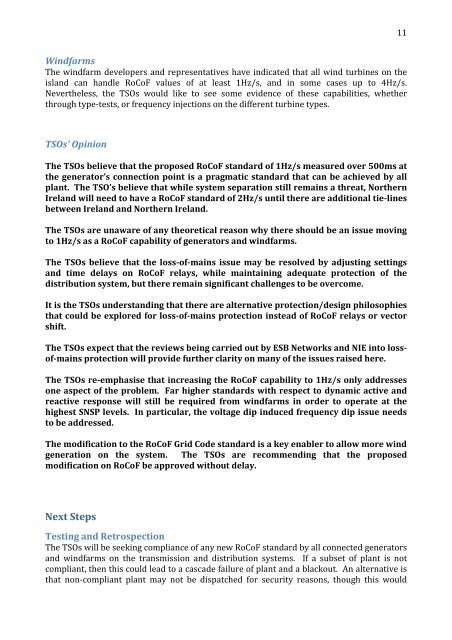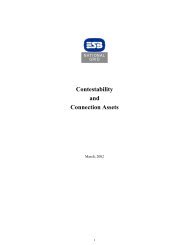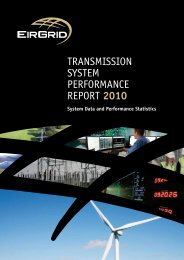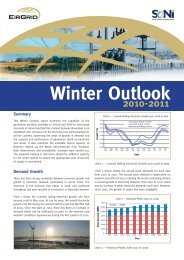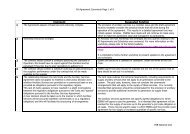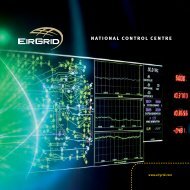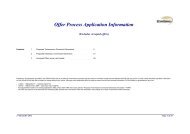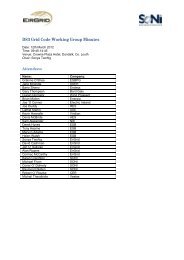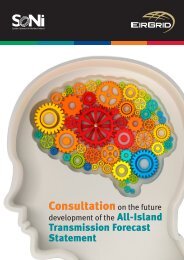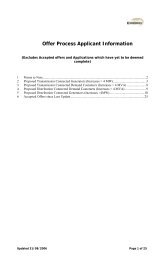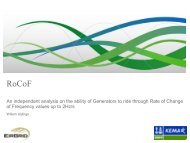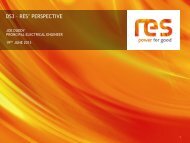10from the machine is less than 0.5pu [6]. The TSOs believe that <strong>RoCoF</strong> events fall intothis category of relatively infrequent system events.Nevertheless, given the concerns expressed by some generators about possible catastrophicfailure of their plant, the TSOs will not operate at higher non-synchronous penetration levelsuntil these fears have been allayed to the TSOs’ satisfaction.DSOsOn the issue of loss-of-mains protection and <strong>RoCoF</strong> relays, the TSOs understand andacknowledge that each DSO has a licensed obligation to ensure the safe and secure operationof the distribution systems. The TSOs will not operate the power system in a way that wouldadversely affect the security standards of the DSOs.• It is the TSOs belief that the existing loss-of-mains protection could be altered, eitherby settings changes, or moving to alternative protection philosophies, to help resolvethe loss-of-mains issue, while maintaining adequate protection against the islandingof generation on the distribution system.• The TSOs acknowledge that in cases where load and generation are balanced in anisland, it is already difficult to provide adequate loss-of-mains protection. In generalprotection employed on the distribution networks includes under- and overfrequencyelements, and under- and over-voltage elements, as well as loss-of-mainsprotection. Work is required to understand and determine the appropriate settingsthroughout the distribution protection schemes that can adequately detect loss-ofmainsin balanced islands. This may require an assessment of the probability of suchbalanced islands occurring.• There exist other anti-islanding protection philosophies and network designs whichcould be explored, although there may be a cost associated with this.• It is the TSOs’ understanding that <strong>RoCoF</strong> protection for anti-islanding is not widelyused, apart from Ireland, UK, Belgium, and Denmark. In Belgium and Denmark, thetypical settings of <strong>RoCoF</strong> relays are in excess of 1Hz/s [9]. However, there may bedifferent standards and policies on electrical islands and earthing in those countries,and in countries that don’t use <strong>RoCoF</strong> protection. In Great Britain, the standardsetting for <strong>RoCoF</strong> protection is 0.125Hz/s.• <strong>RoCoF</strong> relays, if not set correctly, can be responsible for unnecessary trips, and thereis evidence that they have been responsible for some spurious trippings of windfarmsin Ireland in the past.• Distribution-connected generation in Northern Ireland generally use vector shiftrather than <strong>RoCoF</strong>. It is predominantly the earliest wind farms that still use <strong>RoCoF</strong>and there has also been evidence that some generators have changed from <strong>RoCoF</strong> tovector shift protection.• Research carried out on loss-of-mains protection has indicated that vector-shift relayscan be prone to nuisance tripping if not set correctly, and so it should not be inferredthat vector-shift relays are any better or any worse than <strong>RoCoF</strong> relays.The final reports from the DSOs will give more clarity on the next steps in relation to thesematters.
11WindfarmsThe windfarm developers and representatives have indicated that all wind turbines on theisland can handle <strong>RoCoF</strong> values of at least 1Hz/s, and in some cases up to 4Hz/s.Nevertheless, the TSOs would like to see some evidence of these capabilities, whetherthrough type-tests, or frequency injections on the different turbine types.TSOs’ OpinionThe TSOs believe that the proposed <strong>RoCoF</strong> standard of 1Hz/s measured over 500ms atthe generator’s connection point is a pragmatic standard that can be achieved by allplant. The TSO’s believe that while system separation still remains a threat, NorthernIreland will need to have a <strong>RoCoF</strong> standard of 2Hz/s until there are additional tie-linesbetween Ireland and Northern Ireland.The TSOs are unaware of any theoretical reason why there should be an issue movingto 1Hz/s as a <strong>RoCoF</strong> capability of generators and windfarms.The TSOs believe that the loss-of-mains issue may be resolved by adjusting settingsand time delays on <strong>RoCoF</strong> relays, while maintaining adequate protection of thedistribution system, but there remain significant challenges to be overcome.It is the TSOs understanding that there are alternative protection/design philosophiesthat could be explored for loss-of-mains protection instead of <strong>RoCoF</strong> relays or vectorshift.The TSOs expect that the reviews being carried out by ESB Networks and NIE into lossof-mainsprotection will provide further clarity on many of the issues raised here.The TSOs re-emphasise that increasing the <strong>RoCoF</strong> capability to 1Hz/s only addressesone aspect of the problem. Far higher standards with respect to dynamic active andreactive response will still be required from windfarms in order to operate at thehighest SNSP levels. In particular, the voltage dip induced frequency dip issue needsto be addressed.The modification to the <strong>RoCoF</strong> Grid Code standard is a key enabler to allow more windgeneration on the system. The TSOs are recommending that the proposedmodification on <strong>RoCoF</strong> be approved without delay.Next StepsTesting and RetrospectionThe TSOs will be seeking compliance of any new <strong>RoCoF</strong> standard by all connected generatorsand windfarms on the transmission and distribution systems. If a subset of plant is notcompliant, then this could lead to a cascade failure of plant and a blackout. An alternative isthat non-compliant plant may not be dispatched for security reasons, though this would


